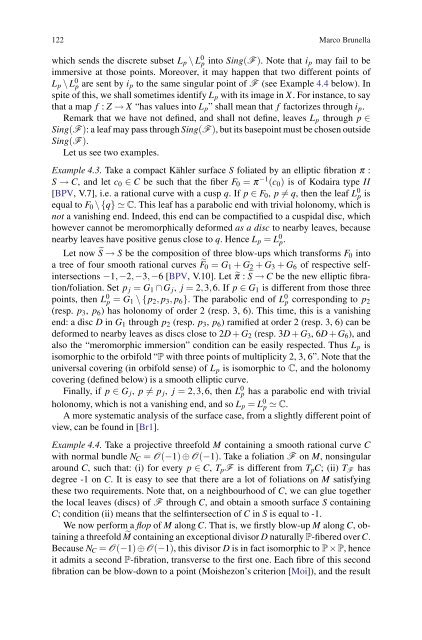Discrete Holomorphic Local Dynamical Systems
Discrete Holomorphic Local Dynamical Systems
Discrete Holomorphic Local Dynamical Systems
You also want an ePaper? Increase the reach of your titles
YUMPU automatically turns print PDFs into web optimized ePapers that Google loves.
122 Marco Brunella<br />
which sends the discrete subset Lp \ L 0 p into Sing(F ). Note that ip mayfailtobe<br />
immersive at those points. Moreover, it may happen that two different points of<br />
Lp \ L 0 p are sent by ip to the same singular point of F (see Example 4.4 below). In<br />
spite of this, we shall sometimes identify Lp with its image in X. For instance, to say<br />
that a map f : Z → X “has values into Lp” shall mean that f factorizes through ip.<br />
Remark that we have not defined, and shall not define, leaves Lp through p ∈<br />
Sing(F ): a leaf may pass through Sing(F ), but its basepoint must be chosen outside<br />
Sing(F ).<br />
Let us see two examples.<br />
Example 4.3. Take a compact Kähler surface S foliated by an elliptic fibration π :<br />
S → C, andletc0∈Cbe such that the fiber F0 = π−1 (c0) is of Kodaira type II<br />
[BPV, V.7], i.e. a rational curve with a cusp q. Ifp ∈ F0, p �= q, then the leaf L0 p is<br />
equal to F0 \{q}�C. This leaf has a parabolic end with trivial holonomy, which is<br />
not a vanishing end. Indeed, this end can be compactified to a cuspidal disc, which<br />
however cannot be meromorphically deformed as a disc to nearby leaves, because<br />
nearby leaves have positive genus close to q. Hence Lp = L0 p .<br />
Let now �S → S be the composition of three blow-ups which transforms F0 into<br />
a tree of four smooth rational curves �F0 = G1 + G2 + G3 + G6 of respective selfintersections<br />
−1,−2,−3,−6[BPV, V.10]. Let �π : �S → C be the new elliptic fibration/foliation.<br />
Set p j = G1 ∩ G j, j = 2,3,6. If p ∈ G1 is different from those three<br />
points, then L0 p = G1 \{p2, p3, p6}. The parabolic end of L0 p corresponding to p2<br />
(resp. p3, p6) has holonomy of order 2 (resp. 3, 6). This time, this is a vanishing<br />
end: a disc D in G1 through p2 (resp. p3, p6) ramified at order 2 (resp. 3, 6) can be<br />
deformed to nearby leaves as discs close to 2D + G2 (resp. 3D + G3,6D + G6), and<br />
also the “meromorphic immersion” condition can be easily respected. Thus Lp is<br />
isomorphic to the orbifold “P with three points of multiplicity 2, 3, 6”. Note that the<br />
universal covering (in orbifold sense) of Lp is isomorphic to C, and the holonomy<br />
covering (defined below) is a smooth elliptic curve.<br />
Finally, if p ∈ G j, p �= p j, j = 2,3,6, then L0 p has a parabolic end with trivial<br />
holonomy, which is not a vanishing end, and so Lp = L0 p � C.<br />
A more systematic analysis of the surface case, from a slightly different point of<br />
view, can be found in [Br1].<br />
Example 4.4. Take a projective threefold M containing a smooth rational curve C<br />
with normal bundle NC = O(−1) ⊕ O(−1). Take a foliation F on M, nonsingular<br />
around C, such that: (i) for every p ∈ C, TpF is different from TpC; (ii) TF has<br />
degree -1 on C. It is easy to see that there are a lot of foliations on M satisfying<br />
these two requirements. Note that, on a neighbourhood of C, we can glue together<br />
the local leaves (discs) of F through C, and obtain a smooth surface S containing<br />
C; condition (ii) means that the selfintersection of C in S is equal to -1.<br />
We now perform a flop of M along C. That is, we firstly blow-up M along C, obtaining<br />
a threefold �M containing an exceptional divisor D naturally P-fibered over C.<br />
Because NC = O(−1) ⊕ O(−1), this divisor D is in fact isomorphic to P × P, hence<br />
it admits a second P-fibration, transverse to the first one. Each fibre of this second<br />
fibration can be blow-down to a point (Moishezon’s criterion [Moi]), and the result



